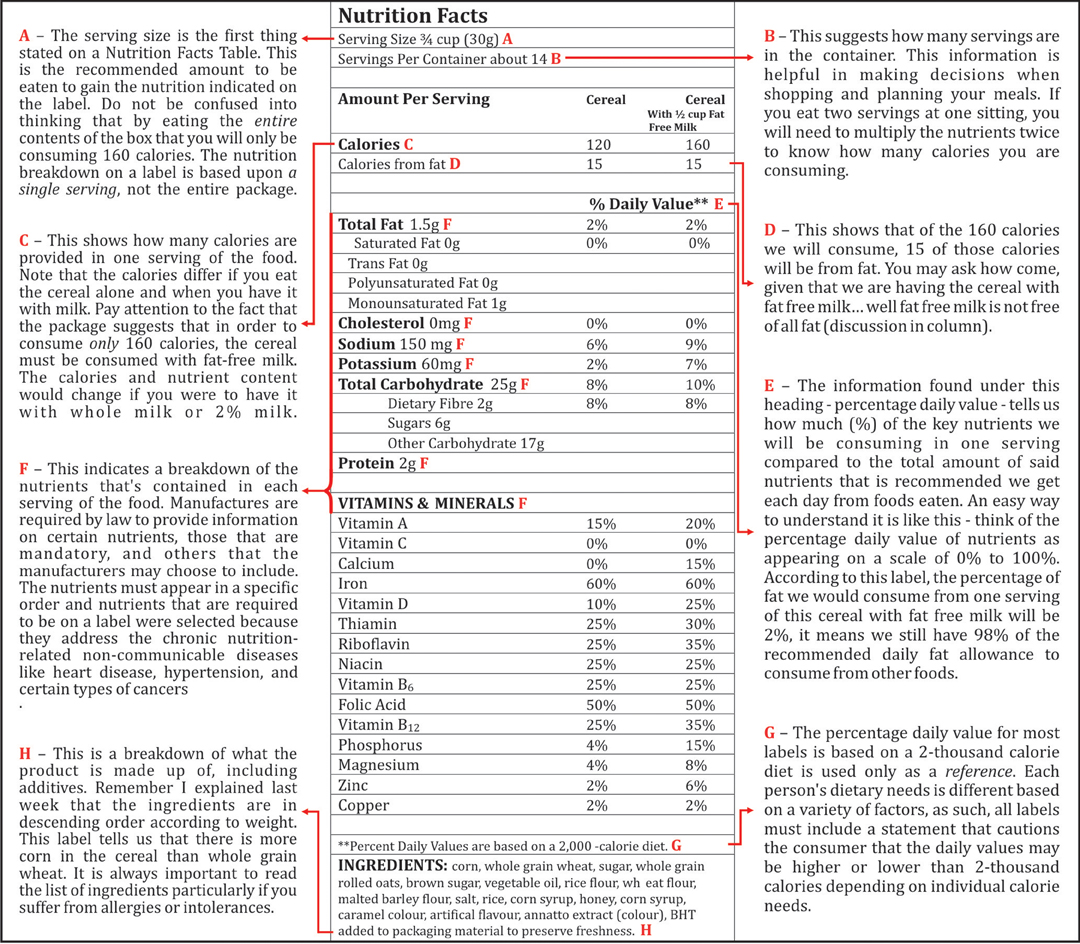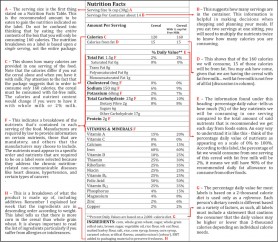Hi Everyone,
Last week we looked at the what, where, who and how of a food label. I explained that a good food label should tell us what the food is, where it comes from, who made it, what’s in it, and how it was made, among other things.

Here’s a sample of a food label. Note carefully the various sections and how to interpret the information.
Additional information
Percent Daily Value (% Daily Value)
I’ve already suggested that an easy way to understand the percent daily value of the nutrients we are supposed to consume is to think of it on a scale of 0% – 100%. In the case of the example outlined in the diagram shown, you will notice that the cereal taken with fat free milk only contains 8% of the daily value of dietary fibre we are allowed. The number 8 is somewhat low on the scale and it tells us two things – one, that the food is not a very good source of the nutrient, fibre, and secondly, that we still have 92% of our daily value of dietary fibre to consume from other foods. Now, when we see the percentage value for the various nutrients on each label, we should be able to ascertain if the product we are consuming is a good source of a particular nutrient, and, it should give us an idea of the remainder of our recommended percent daily value.
Use the following as a guide to interpreting percent daily value on food labels. If the label says that the food contains 5% or less of a particular nutrient, then that product is a low source of the nutrient. If it says 10 – 19%, it is a good source; 20% or more is a high source; 40% and more, then it is an extremely high source. As we can see in the diagram, this cereal is an extremely high source of iron – one serving will give us 60% of our recommended percent daily value!
Nutrition Claims
Many food labels make nutrition claims and these claims are obviously made to entice us to buy the products. There are several types of nutrition claims but two in particular that are very obvious are the health claim and the nutrient-content claim.
Health Claim – this is any claim made on a food label that describes a relationship between nutrients, or a food, and the risk of a disease or health-related condition. When a label makes a health claim, what it is saying is that if you eat this product it can help prevent, help fight or reduce certain things. For example:
► Calcium is linked with osteoporosis
► Dietary saturated fat and cholesterol with heart disease
► Sodium with hypertension
► Fruits and vegetables with cancer.
Nutrient-content claim – this type of claim gives information about a nutrient such as fat, sodium (salt) or sugar. A nutrient-content claim seeks to describe the level or amount of a particular nutrient contained in a food.
Nutrient-content claims bring us to the confusing part of trying to decipher what is fat free, low fat, reduced fat etc. Here’s what it all means.
Low calorie means that the product contains 40 calories or less per serving size.
Reduced calorie means that the product has less than 1/3 to half fewer calories than the normal regular product. For example, if you buy mayonnaise that says: reduced calorie, it means that 1 cup of the reduced calorie mayonnaise will contain 1/3 to half fewer calories than 1 cup of regular mayonnaise.
Calorie free means that the product has less than 5 calories per serving size.
Low fat means that the product must contain less than 3 grammes of fat per serving size.
Fat free means that the product contains less than 0.5 grammes of fat per serving size.
Low saturated fat means the product contains 1 gramme or less of fat per serving size.
Low cholesterol means that the product contains 20 milligrammes or less cholesterol per serving size.
Cholesterol free means that the product has less than 2 milligrammes of cholesterol per serving size. BUT, cholesterol free can also be seen on the labels of products in which cholesterol does not occur naturally! For example, I’m sure that you’ve seen cholesterol free on your vegetable oil bottle – this is a selling gimmick! Cholesterol is only found in foods that have ingredients from animal sources.
No added sugar means that no sugar or sweeteners of any kind have been added during the preparation or packaging. Though there is no added sugar, it does not automatically mean that the product is a low calorie or reduced calorie unless it is. Depending on the product, it may have its own natural sugar/sweetness.
Low sodium means the product has less than 140 milligrammes of sodium per serving size.
Very low sodium means the product has less than 35 milligrammes of sodium per serving size.
Sodium free means the product contains less than 5 milligrammes of sodium per serving size.
Light or lite means that the product contains 1/3 fewer calories or half of the fat of the regular product. It may also mean that the sodium content of a low calorie, low fat food has been reduced by half. Lite can also be used to describe the texture or colour of a product.
Lean means less than 10 grammemes of fat, 4.5 grams or less of saturated fat and less than 95 milligrammes of cholesterol per 3oz serving of meat, poultry or seafood.
Extra lean means less than 5 grammes of fat, less than 2 grammes of saturated fat and less than 95 milligrammes of cholesterol per 3 oz serving.
High Fibre means that the product must contain at least 6 grammes of fibre per serving size
Source of Fibre means the product must contain at least 3 grammes of fibre per serving.
The important thing to note here is this – not because a product says that it is fat free, sodium free or sugar free, that it is a licence to over indulge. If you eat more than the recommended serving then you will automatically be increasing your intake of fat, sodium and sugar. As you can see from information outlined in the various nutrient-content claims, the foods labelled are not completely void of any of the nutrients – fat, sodium or sugar.
Standard labelling terms
In addition to the nutrition facts table, the name of the manufacturer, processors, various dates of use etc, there are other information to be found on food labels and are placed prominently in order to “catch the eye” and promote certain components of the product. Here are some of the most commonly used terms and what they mean.
Natural – this means that the food contains no added vitamins, minerals, artificial flavouring agents or food additives. This does not mean, however, that the food is naturally “healthier”.
Healthy – this is used to describe foods that are low in fat and saturated fat and contain no more that 360 milligrammes of sodium, no more than 60 milligrammes of cholesterol per serving, and provide at least 10% daily value for Vitamins A and C or iron, calcium or dietary fibre.
Fresh – this may be used to describe foods that are raw and have never been frozen or heated and contain no preservatives.
Enriched – this is the process whereby the nutrients lost during processing have been added back to an equal level or higher than originally present.
Fortified – nutrients are added to a product in which such nutrients are not naturally present. For example, the addition of Vitamin D to milk and the mineral iodine to salt.
Whole grain – the food contains the entire kernel, the outermost part called the bran (which contains most of the fibre and is a good source of the B vitamins). The germ, lies at the base of the kernel (rich source of Vitamin E) and the endosperm that is mainly starch (contains most of the protein and some vitamins and minerals). Such whole grain products are whole wheat flour, cornmeal, brown rice, and oat meal.
I hope that after reading this series that you are more informed about food labels and that you will use the information to help make the choices that are right for you and your family as we strive to meet our dietary needs. Let’s all make the effort to be informed consumers. My hope also, is that you will save this information and return to it often and even take it shopping with you.
Cynthia
tasteslikehome@gmail.com
www.tasteslikehome.org


